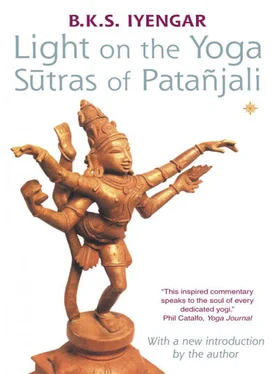The four chapters or padas of the book are:
1 Samadhi pada (on contemplation)
2 Sadhana pada (on practice)
3 Vibhuti pada (on properties and powers)
4 Kaivalya pada (on emancipation and freedom)
The four padas correspond to the four varñas or divisions of labour; the four asramas or stages of life; the three guñas or qualities of nature and the fourth state beyond them ( sattva, rajas, tamas and guatita) and the four purusarthas or aims of life. In the concluding sutra of the fourth pada, Patañjali speaks of the culmination of purusarthas and gunas as the highest goal of yoga sadhana. These concepts must have been wholly understood in Patañjali’s time, and therefore implicit in the earlier chapters, for him to speak of them explicitly only at the very end of the book.
The ultimate effect of following the path laid out by Patañjali is to experience the effortless, indivisible state of the seer.
The first pada amounts to a treatise on dharmasastra, the science of religious duty. Dharma is that which upholds, sustains, and supports one who has fallen or is falling, or is about to fall in the sphere of ethics, physical or mental practices, or spiritual discipline. It appears to me that Patañjali’s whole concept of yoga is based on dharma , the law handed down in perpetuity through Vedic tradition. The goal of the law of dharma is emancipation.
If dharma is the seed of yoga, kaivalya (emancipation) is its fruit. This explains the concluding sutra, which describes kaivalya as the state which is motiveless and devoid of all worldly aims and qualities of nature. In kaivalya , the yogi shines in his own intelligence which sprouts from the seer, atman , independent of the organs of action, senses of perception, mind, intelligence and consciousness. Yoga is, in fact, the path to kaivalya.
Dharma , the orderly science of duty is part of the eightfold path of yoga (astanga yoga), which Patañjali describes in detail. When the eight disciplines are followed with dedication and devotion, they help the sadhaka to become physically, mentally and emotionally stable so that he can maintain equanimity in all circumstances. He learns to know the Supreme Soul, Brahman , and to live in speech, thought and action in accordance with the highest truth.
The first chapter, samadhi pada , defines yoga and the movement of the consciousness, citta vrtti. It is directed towards those who are already highly evolved to enable them to maintain their advanced state of cultured, matured intelligence and wisdom. Rare indeed are such human souls who experience samadhi early in life, for samadhi is the last stage of the eightfold path of yoga. Samadhi is seeing the soul face to face, an absolute, indivisible state of existence, in which all differences between body, mind and soul are dissolved. Such sages as Hanuman, suka, Dhruva, Prahlada, sankaracarya, Jñanesvar, Kabir, Svami Ramdas of Maharastra, Ramakrsna Paramahamsa and Ramata Maharsi, evolved straight to Kaivalya without experiencing the intermediate stages of life or the various stages of yoga. All the actions of these great seers arose from their souls, and they dwelled throughout their lives in a state of unalloyed bliss and purity.
The word samadhi is made up of two components. Sama means level, alike, straight, upright, impartial, just, good and virtuous; and adhi means over and above, i.e. the indestructible seer. Samadhi is the tracing of the source of consciousness – the seer – and then diffusing its essence, impartially and evenly, throughout every particle of the intelligence, mind, senses and body.
We may suppose that Patañjali’s intention, in beginning with an exegesis of samadhi , was to attract those rare souls who were already on the brink of Self-Realization, and to guide them into experiencing the state of nonduality itself. For the uninitiated majority, the enticing prospect of samadhi , revealed so early in his work, serves as a lamp to draw us into yogic discipline, which will refine us to the point where our own soul becomes manifest.
Patañjali describes the fluctuations, modifications and modulations of thought which disturb the consciousness, and then sets out the various disciplines by which they may be stilled. This has resulted in yoga being called a mental sadhana (practice). Such a sadhana is possible only if the accumulated fruits derived from the good actions of past lives (samskaras) are of a noble order. Our samskaras are the fund of our past perceptions, instincts and subliminal or hidden impressions. If they are good, they act as stimuli to maintain the high degree of sensitivity necessary to pursue the spiritual path.
Consciousness is imbued with the three qualities (gunas) of luminosity ( sattva ), vibrancy ( rajas ) and inertia ( tamas). The gunas also colour our actions: white ( sattva ), grey ( rajas ) and black ( tamas). Through the discipline of yoga, both actions and intelligence go beyond these qualities and the seer comes to experience his own soul with crystal clarity, free from the relative attributes of nature and actions. This state of purity is samadhi. Yoga is thus both the means and the goal. Yoga is samadhi and samadhi is yoga.
There are two main types of samadhi. Sabija or samprajñata samadhi is attained by deliberate effort, using for concentration an object or idea as a ‘seed’. Nirbija samadhi is without seed or support.
Patañjali explains that before samadhi is experienced the functioning of consciousness depends upon five factors: correct perception, misperception (where the senses mislead), misconception or ambiguousness (where the mind lets one down), sleep, and memory. The soul is pure, but through the sullying or misalignment of consciousness it gets caught up in the spokes of joys and sorrows and becomes part of suffering, like a spider ensnared in its own web. These joys and sorrows may be painful or painless, cognizable or incognizable.
Freedom, that is to say direct experience of samadhi , can be attained only by disciplined conduct and renunciation of sensual desires and appetites. This is brought about through adherence to the ‘twin pillars’ of yoga, abhyasa and vairagya.
Abhyasa (practice) is the art of learning that which has to be learned through the cultivation of disciplined action. This involves long, zealous, calm, and persevering effort. Vairagya (detachment or renunciation) is the art of avoiding that which should be avoided. Both require a positive and virtuous approach.
Practice is a generative force of transformation or progress in yoga, but if undertaken alone it produces an unbridled energy which is thrown outwards to the material world as if by centrifugal force. Renunciation acts to shear off this energetic outburst, protecting the practitioner from entanglement with sense objects and redirecting the energies centripetally towards the core of being.
Patañjali teaches the sadhaka to cultivate friendliness and compassion, to delight in the happiness of others and to remain indifferent to vice and virtue so that he may maintain his poise and tranquillity. He advises the sadhaka to follow the ethical disciplines of yama and niyama , the ten precepts similar to the Ten Commandments, which govern behaviour and practice and form the foundation of spiritual evolution. He then offers several methods through which consciousness detaches itself from intellectual and emotional upheavals and assumes the form of the soul – universal, devoid of all personal and material identity. The sadhaka is now filled with serenity, insight and truth. The soul, which until now remained unmanifest, becomes visible to the seeker. The seeker becomes the seer: he enters a state without seed or support, nirbija samadhi.
Читать дальше












